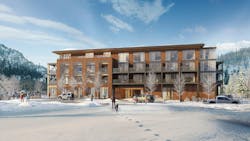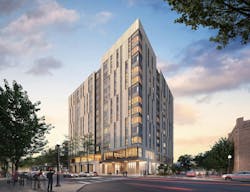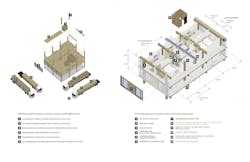Mass timber is becoming a more common design choice for DLR Group
The architecture firm DLR Group has been methodically relying on mass timber, with more than 3 million sf of that building material now in the firm’s design portfolio.
Among its recent mass timber projects is 9th and High, the first large-scale student housing building in Columbus, Ohio, to use the product in its construction, which broke ground in September near Ohio State University’s’ campus.
Harbor Bay Ventures is the developer of this 13-story, 242,000-sf building, which upon its completion in the summer of 2027 will be the tallest mass-timber student housing structure in the U.S. SmartLam North America is supplying the mass timber from its plant in Alabama. Forefront Structural Engineers collaborated with SmartLam on the student housing building’s structural design.
The 493-bed building “paves the way for the future of low-carbon, innovative student housing … where mass timber’s natural warmth and texture shape vibrant, engaging housing communities that support connection and focus,” said Cameron K. Jacobson, AIA, CDT, Senior Associate and Project Architect at DLR Group, in a prepared statement.
By using mass timber, this project is expected to realize a net COe2 sequestration of 1,128 metric tons, the equivalent of 2,169 roundtrip flights from Columbus to Key West, Fla., said Josh Dortzbach, CEO of Forefront Structural Engineers.
DLR Group's first mass timber hotel
DLR Group has also expanded its use of mass timber to its hospitality practice. Its latest venture in that direction is Common Pine, the firm’s first mass-timber hotel project and the first of its kind in the Lake Tahoe region.
In September, DLR Group unveiled its design for this 80,000-sf, 75-key hotel, located in Truckee, Calif., in the Sierra Nevada mountains. The hotel was created in partnership with Rikesh Patel, who founded the Common Pine hospitality brand, which emphasizes the link between humanity and the natural world. The design includes exposed timber frames and a façade that incorporates fluted natural wood siding.
DLR Group states that the hotel project builds on the firm’s portfolio of mass timber office projects, as part of its decade-long partnership with the global developer Hines. DLR Group’s expansion of mass timber for hospitality projects stems from a 2023 viability study the firm conducted with the U.S. Forest Service and developed with a USDA Wood Innovation Grant.
“Common Pine demonstrates how we can use mass timber design in a new way, not just as a building material but as a medium for storytelling, connection, and innovation,” said Stephen Cavanaugh, FAIA, LEED AP, Principal and Design Leader, DLR Group.
Weighing the tradeoffs
In an email response to BD+C’s questions, Cavanaugh said that using mass timber “comes down to the value system of the client.” He noted that most of DLR Group’s timber portfolio is comprised of buildings with budgets that are tight and finite. “Ultimately, they are built for monetary return on investment.” He added that the speculative timber office projects that DLR Group has done with Hines “are proof of financial viability” whose monetary value is in their “beauty, wellness, and environmental sustainability.”
When choosing mass timber, he elaborated, there needs to be alignment between a project’s density goals and the constraints of timber building code limitations. “That’s where the conversation usually starts: if the size and height of the development thesis can be manifested as an exposed timber or partially exposed timber structure, then we will most likely explore the option.”
About the Author

John Caulfield
John Caulfield is Senior Editor with Building Design + Construction Magazine.


